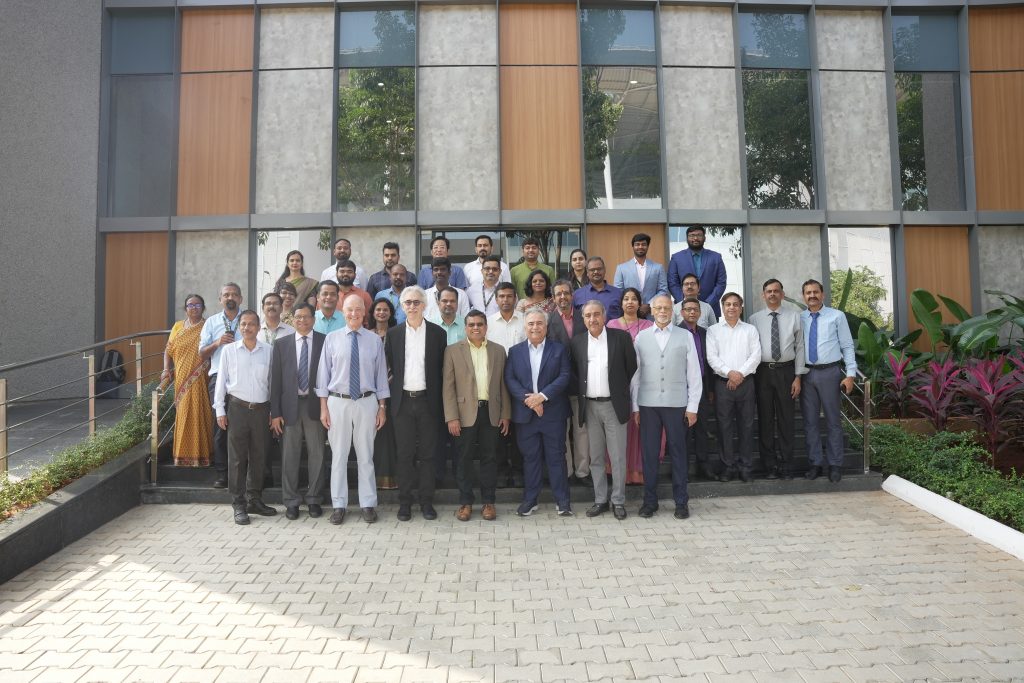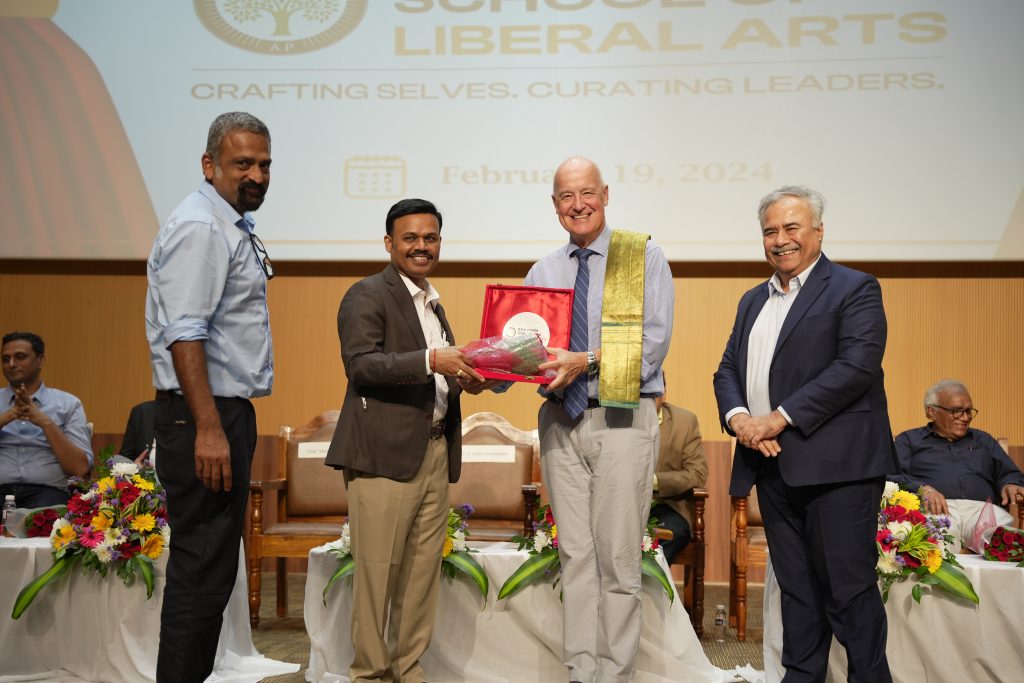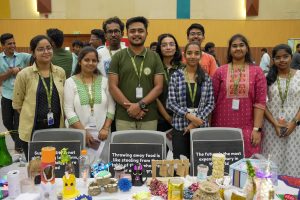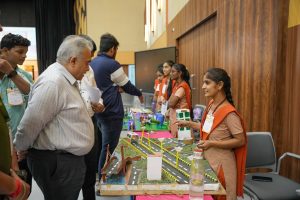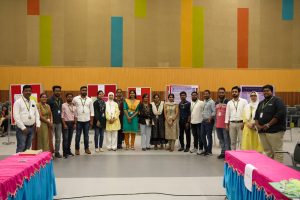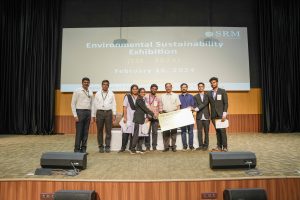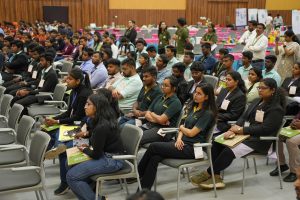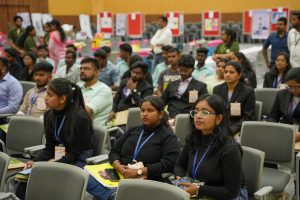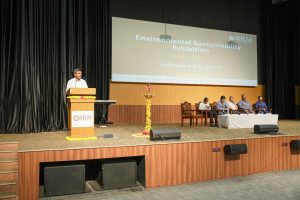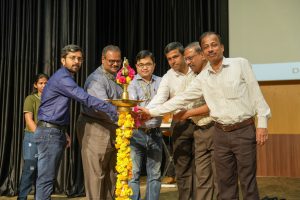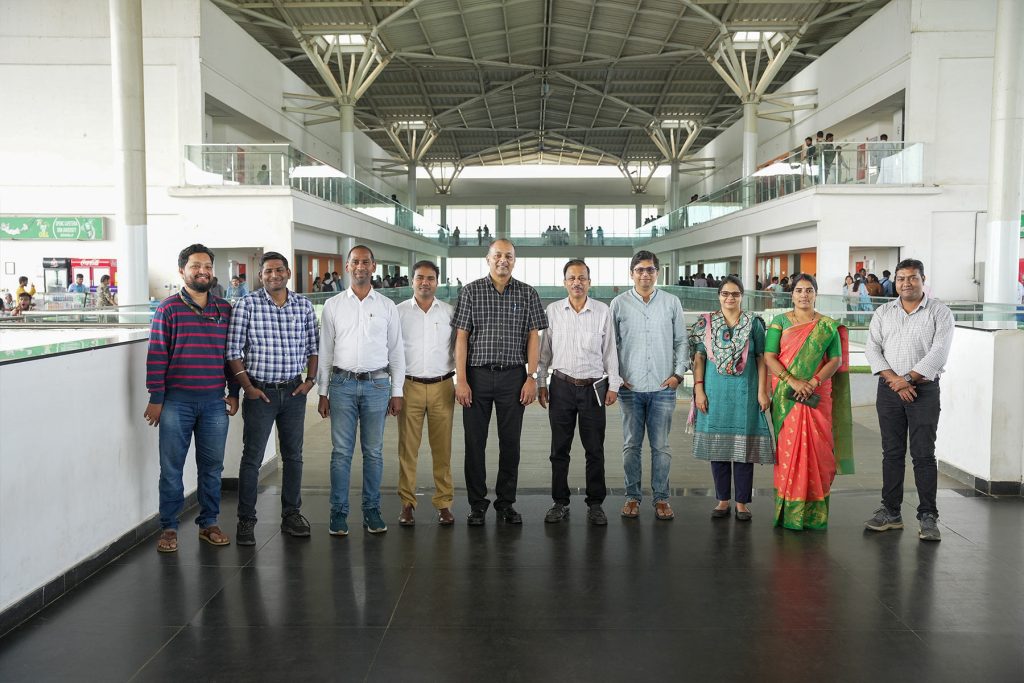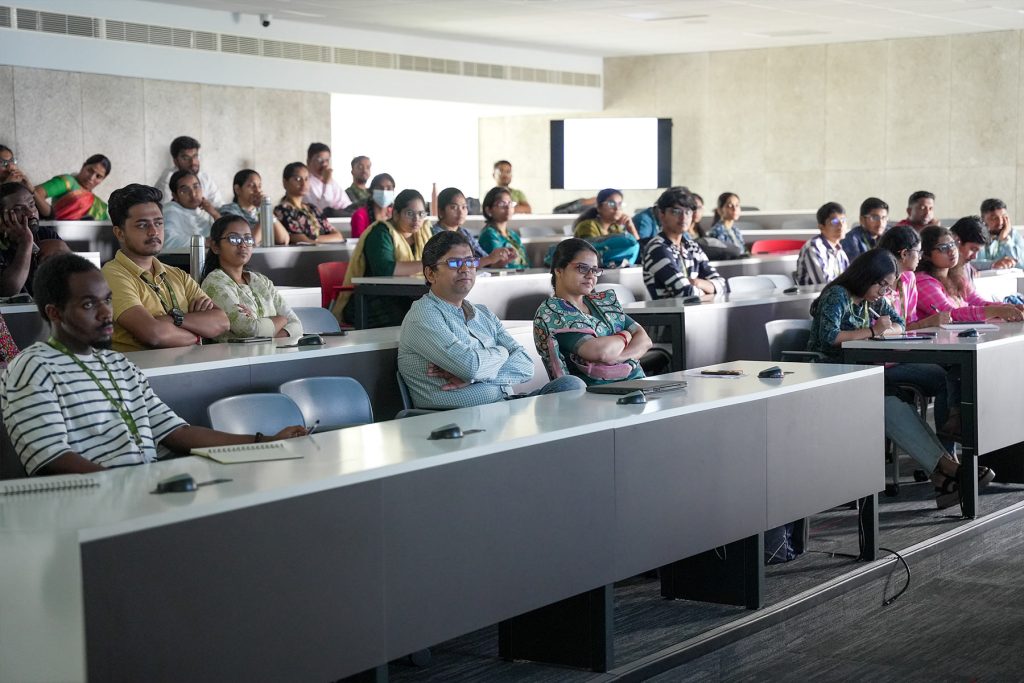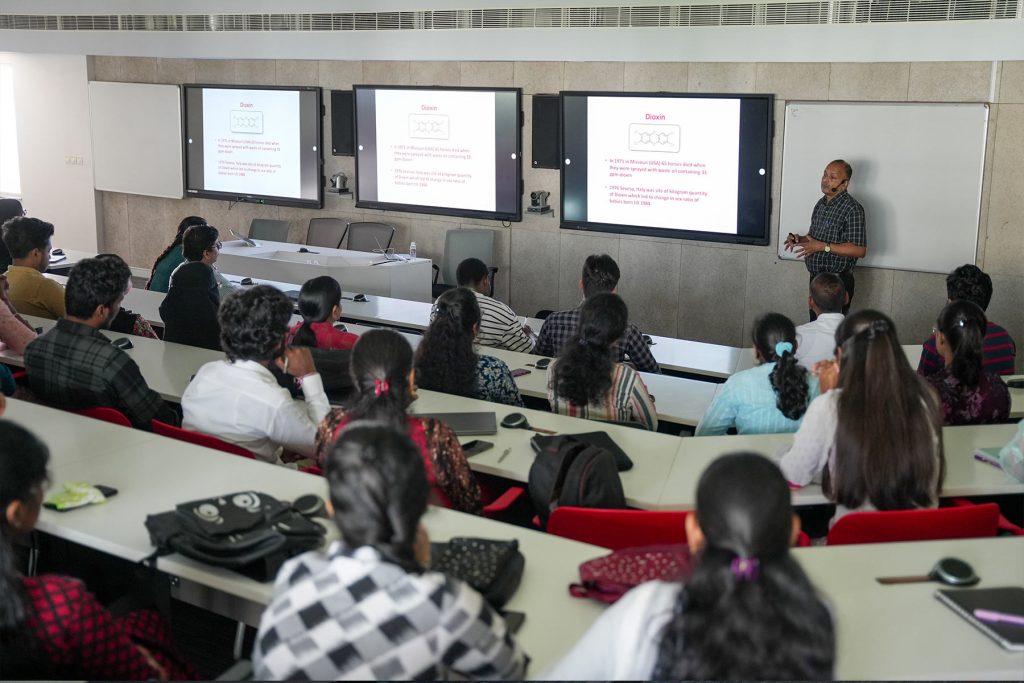Shaping an Academic Scholarly Milieu: Grand Launch of Easwari School of Liberal Arts
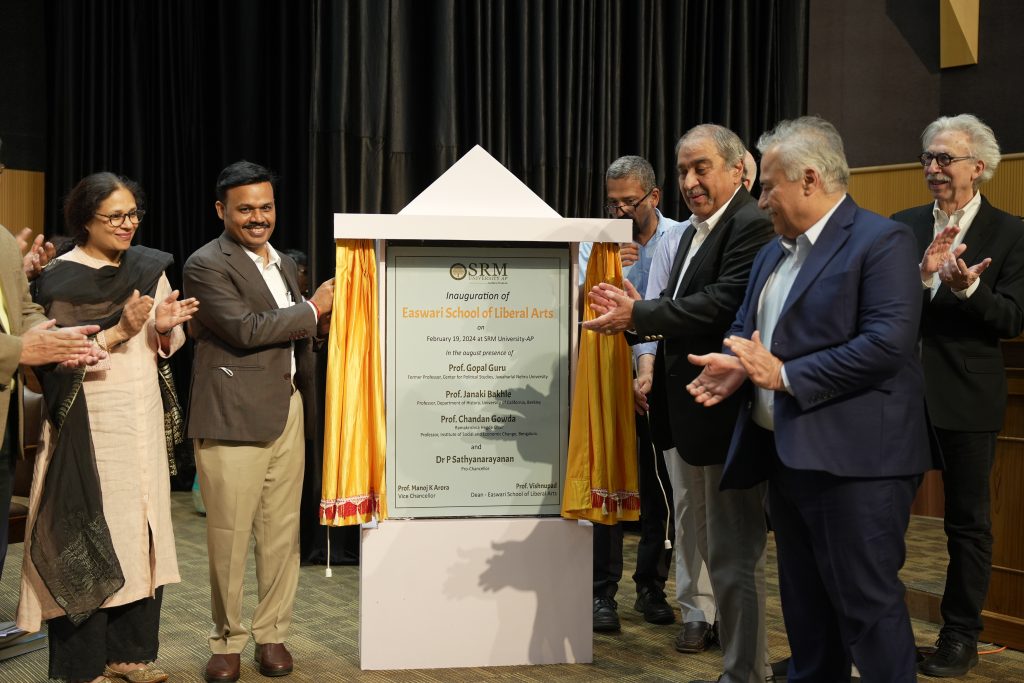
SRM University-AP relaunched the School of Liberal Arts and Social Sciences as the Easwari School of Liberal Arts, establishing a new era of transformative learning and research to address the complexities of human society. The school was inaugurated in the august presence of Pro-Chancellor Dr P Sathyanarayanan; Vice Chancellor Prof. Manoj K Arora; Members of the Governing Body – Prof. Pradeep Khosla, Chancellor, University of California, San Diego, Prof. Nicholas B Dirks, Emeritus Chancellor, University of California, Berkeley, Prof. Prasant Mohapatra, Vice Chancellor for Research and Provost and Vice President for Academic Affairs, University of South Florida, and Prof. Andrew D Hamilton, President, New York University; Dean – Easwari School of Liberal Arts, Prof. Vishnupad; Deans and Directors of various departments and faculty, staff and students of the university. Prof. Gopal Guru, Former Professor, Center for Political Studies, JNU; Prof. Janaki Bakhle, Associate Professor at the University of California, Berkeley; and Prof. Chandan Gowda, Ramakrishna Hegde Chair Professor, Institute of Social and Economic Change, Bengaluru, graced the momentous occasion as Guests of Honour.
The rechristened Easwari School of Liberal Arts aims to propel students’ intellectual, emotional and ethical growth, equipping them to become future knowledge creators. “The launch of Easwari School of Liberal Arts is a testament to the university’s commitment to interdisciplinary learning and research. Through a sound liberal arts education, we aim to cultivate diversified skills among our students,” remarked Vice Chancellor Prof. Manoj K Arora in his address. Prof. Vishnupad, Dean – Easwari School of Liberal Arts, further expounded on the symbolic renaming of the school and its established imperative to foster a three-fold growth in students – emotional, ethical and intellectual.
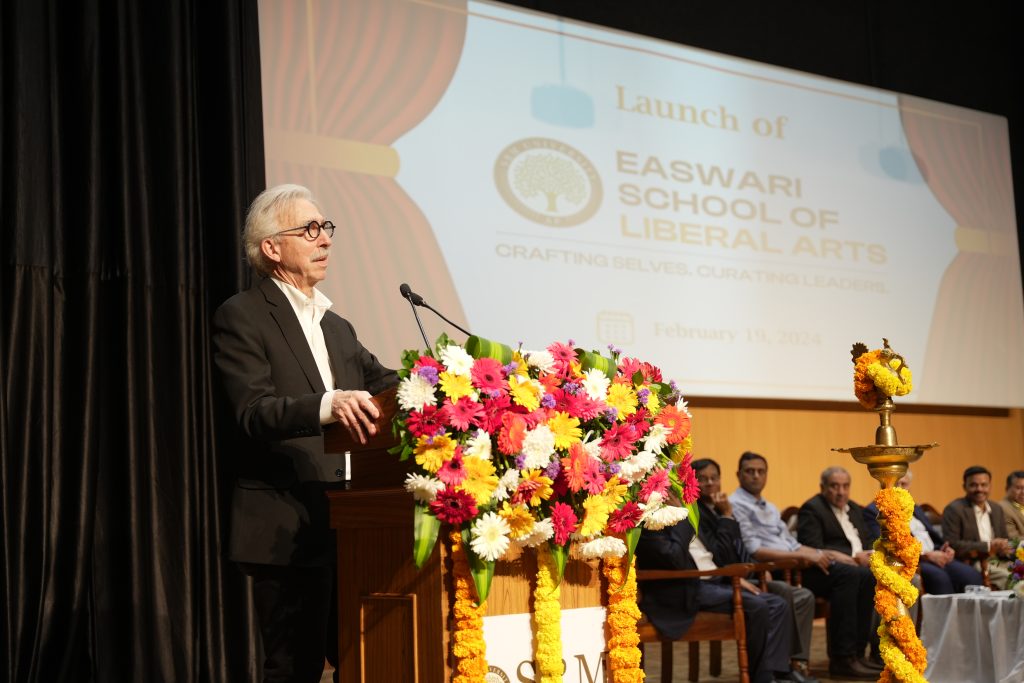
Pro-Chancellor, Dr P Sathyanarayanan commented that Easwari School of Liberal Arts opens the doorway to a brave new world of learning that will forge visionary thinkers. The School advocates breaking the academic silos of disciplines and offering students a more comprehensive integrated learning experience. In his address, Prof. Nicholas Dirks, Honourary Pro-Chancellor and a Governing Body member of SRM AP, stated, “Liberal Arts is a constitutive element of comprehensive education. SRM University-AP, with the launch of a dedicated School of Liberal Arts, is on its path to develop into an excellent comprehensive institute of higher education.”
The grand launch also witnessed a keynote speech by Guest of Honour, Prof. Gopal Guru, on the significance of liberal arts education in comprehending, analysing and solving the complexities of postmodern society. Insightful and inspiring book discussions on the books “Savarkar and the Making of Hindutva”, authored by Prof. Janaki Bakhle and “Another India: Events, Memories, People”, by Prof. Chandan Gowda, offering critical insights into the raw sentimentality of Indian society were highlights of the event.
The Easwari School of Liberal Arts harbours a robust, socially relevant, innovative curriculum, a distinguished and committed faculty, and imaginative and engaged teaching and learning methods to cultivate a class of motivated student ambassadors of tomorrow. In addition to offering traditional programmes such as B.A/B.Sc.(Hons.) in English, Economics, History, Psychology and B.Com in International Accounting; the School has also launched three pioneering programmes, namely, B.A. (Hons.) in Politics, Media Studies and Sociology and Anthropology, to equip students on how to address the socio-political, cultural and economic outlook of today’s society. With a novel pedagogy, these innovative programmes nurture logical reasoning, dynamic perspectives, rigour in thought and ideas, and critical reflection among students.
- Published in News, SLASS, University Event
ESE 2024: Promoting Environmental Sustainability Through Innovation
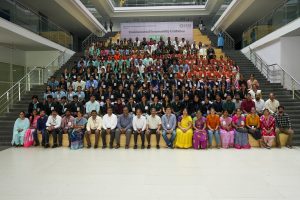 In a remarkable display of commitment towards environmental sustainability, the Department of Environmental Science and Engineering successfully organised the ESE 2024 event. The primary objective of this event was to create awareness and encourage innovative solutions for addressing environmental challenges.
In a remarkable display of commitment towards environmental sustainability, the Department of Environmental Science and Engineering successfully organised the ESE 2024 event. The primary objective of this event was to create awareness and encourage innovative solutions for addressing environmental challenges.
More than 150 enthusiastic undergraduate students from Gujarat, West Bengal, Uttarakhand, Odisha and Tamil Nadu participated in the event. Their active involvement exemplified the youth’s growing interest and concern for environmental issues.
After a highly competitive and captivating competition, the winners were finally announced. The first prize was awarded to Andhra Loyola College, the second prize went to Natubhai V. Patel College of Pure Applied Sciences, and the third prize was claimed by Government Autonomous College, Rourkela.
The winners were not only recognised for their outstanding performances but also received substantial cash prizes. The first-place winner was awarded a cash prize of INR 30,000/-, the second-place winner received INR 20,000/-, and the third-place winner was granted INR 10,000/-.
Additionally, consolation prizes of INR 5,000/- each were distributed to students securing positions from 4th to 10th. Recipients included students from Manipal Academy of Higher Education, Doon Business School, Saveetha Institute of Medical and Technical Sciences (SIMATS), Central University of Tamil Nadu, Sri Durga Malleswara Siddhartha Mahila Kalasala, Nehru Arts and Science College, and SRR & CVR Govt. Degree College.
The ESE 2024 event served as a platform for young minds to showcase their talents and exchange ideas, engage in meaningful discussions, and collaborate on initiatives aimed at promoting environmental sustainability. The exhibition featured a diverse range of projects spanning areas such as renewable energy, waste management, conservation efforts, and sustainable agriculture, among others.
- Published in Departmental News, ENVS News, News
Revolutionising Sustainable Living: A Discourse on Green Chemistry

In a world of fast-escalating environmental challenges, the idea of sustainability comes as a ray of hope for a safe and sound future. The present scenario calls for the kind of development that meets the needs of the present without compromising the future. In this regard, the Department of Chemistry at SRM University-AP organised a colloquium, that aimed to provide students with a comprehensive understanding of the concepts of Green Chemistry.
Dr Ram Mohan, an expert in the field of Green Chemistry and a renowned academician at the Department of Chemistry, Illinois Wesleyan University, delivered a lecture on the topic “Better Living Through Green Chemistry: An Introduction to Toxic Molecules”. Dr Mohan spoke elaborately on the grave dangers of toxic molecules and their adverse effects on the environment and human health. He raised awareness about the critical role of green chemistry in reducing the usage of such harmful molecules and replacing them with environmentally safe alternatives.
Dr Mohan also conducted workshops on “Better Living Through Green Chemistry”, as a continuation of his lecture. During the workshop, he quoted several case studies that showcased the benefits of using environmentally safe processes and chemicals in industry. These case studies demonstrated how the practice of green chemistry can lead to the development of numerous Eco-friendly processes and chemicals that have greatly improved human life and reduced environmental impact.
- Published in Chemistry-news, Departmental News, News
Rethinking Ionic Liquids as an Environment-friendly Solvent
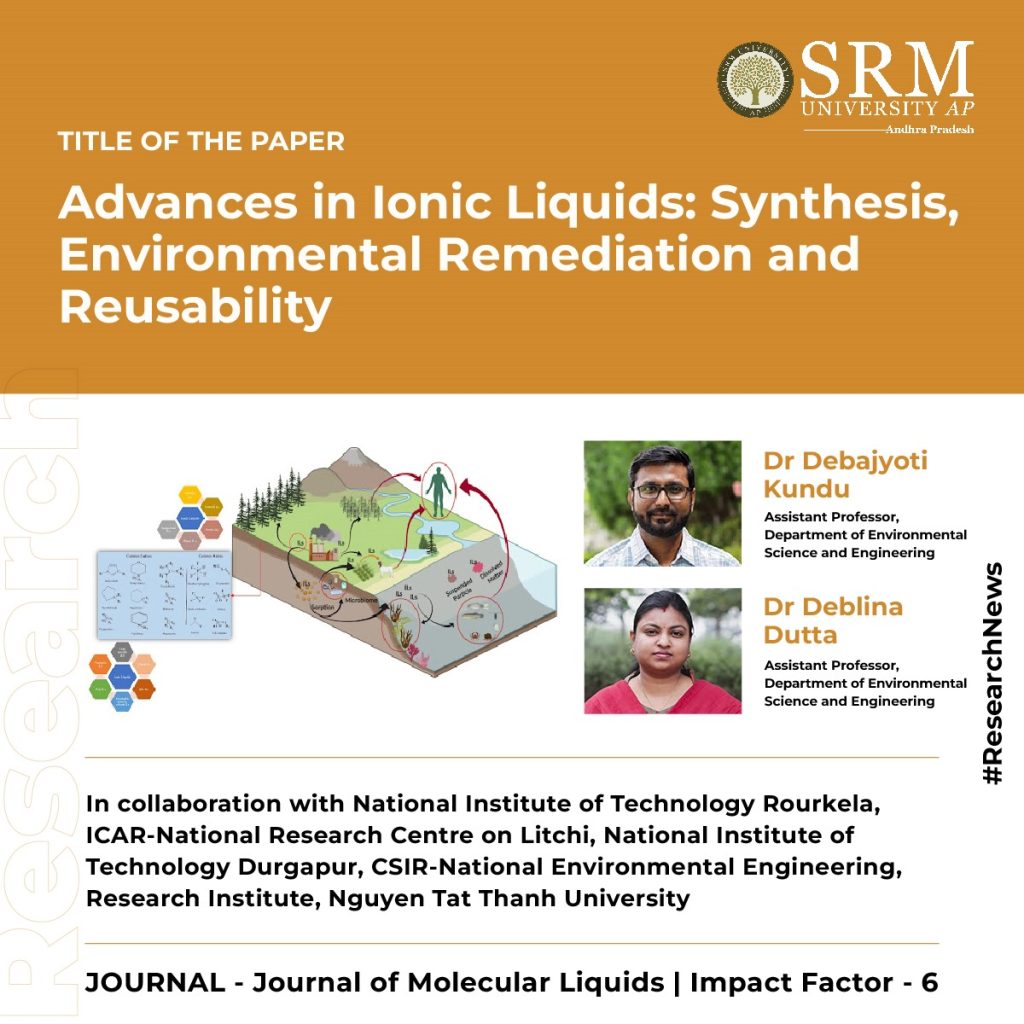
Dr Debajyoti Kundu and Dr Deblina Dutta, Assistant Professors, Department of Environmental Science and Engineering, have conducted seminal research on Ionic Liquids (ILs) in their paper “Advances in ionic liquids: Synthesis, environmental remediation and reusability” published in the Q1 journal, Journal of Molecular Liquids with an impact factor of 6. In the research article, the faculty duo have delved into the unique properties of ionic liquids, focusing on their role in environmental cleanup and showcasing their ability to combat pollutants. Various methods to recycle and reuse ILs, develop eco-friendly ILs, and scale up their application for effective environmental remediation have also been extensively explored.
Abstract
Ionic liquids (ILs) are next-generation solvents synthesised by organic salts, possessing negligible vapour pressure and low flammability. They possess high thermal and electrochemical stability, can be reused for multiple cycles, and their properties can be tuned according to the components used in their synthesis. Hence, ILs are considered to be potential alternatives for conventional organic solvents for numerous applications such as environmental remediation, nanoparticle synthesis, catalysts in various chemical reactions, solvents for the extraction of biomolecules from recalcitrant lignocellulosic biomass, etc. In this review article, the holistic approach of ILs, starting from various techniques adopted for their synthesis along with its critical review, is discussed, followed by a detailed discussion of the mechanism involved in the remediation of environmental pollutants using ILs. Further, in-depth documentation of various environmental pollutants remediated using ILs has been done to date. One of the major drawbacks of solvent application is the reusability factor, and hence, in this review article, techniques adopted to recycle/reuse ILs have been discussed. Further, the adverse effects of using ILs for environmental remediation have been comprehensively discussed to present a holistic view. Future studies should focus on synthesising environment-friendly ILs and their field-scale applications for environmental remediation.
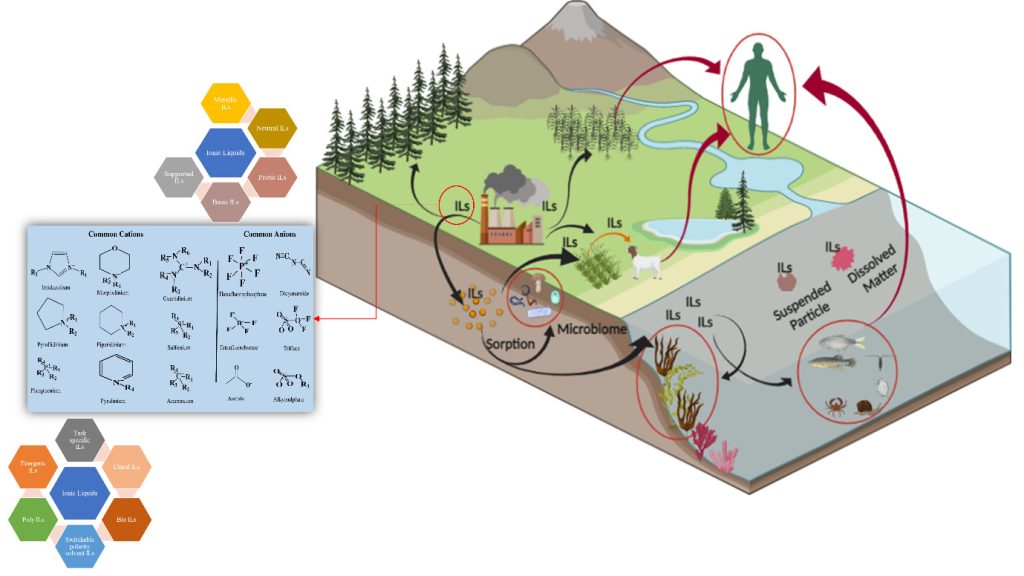
Practical implementation/social implications of the research
Their research on Ionic Liquids (ILs) presents a transformative approach to environmental challenges. By applying ILs on a larger scale for cleaning polluted air and water, promoting recycling and reusability, and developing eco-friendly ILs, the work has direct implications for industries and communities. The adoption of IL-based technologies contributes to efficient environmental cleanup and aligns with the growing societal demand for sustainable practices. Successful field-scale applications and public awareness initiatives can lead to a cleaner and healthier environment, demonstrating the tangible benefits of incorporating ILs into real-world solutions and fostering a more responsible and eco-conscious society.
Collaborations:-
- National Institute of Technology Rourkela
- ICAR-National Research Centre on Litchi
- National Institute of Technology Durgapur
- CSIR-National Environmental Engineering Research Institute
- Nguyen Tat Thanh University
Dr Kundu and Dr Dutta remarks that their future research in the realm of Ionic Liquids (ILs) will prioritise the development of environmentally sustainable synthesis methods, rigorous assessments of biodegradability and toxicity, and integrating ILs into industrial processes. Scaling up studies to evaluate their effectiveness in large-scale environmental remediation, investigating public perceptions, and fostering multidisciplinary collaborations with experts from diverse fields will be crucial for the responsible adoption of IL-based technologies. Additionally, focusing on life cycle assessments, exploration of novel applications, policy recommendations, and educational outreach can collectively contribute to advancing the understanding and practical implementation of ILs, ensuring a holistic and impactful approach to their environmental applications.
Click to read the article!
- Published in Departmental News, ENVS News, News, Research News


